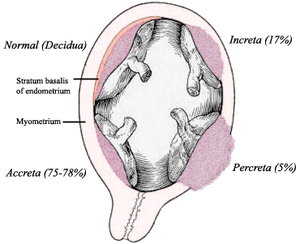Placenta accreta
| Placenta accreta | |
|---|---|
 |
|
| Types of placenta accreta | |
| Classification and external resources | |
| Specialty | obstetrics |
| ICD-10 | O43.2 |
| ICD-9-CM | 667.0 |
| DiseasesDB | 10091 |
| MeSH | D010921 |
Placenta accreta occurs when all or part of the placenta attaches abnormally to the myometrium (the muscular layer of the uterine wall). Three grades of abnormal placental attachment are defined according to the depth of invasion:
Because of abnormal attachment to the myometrium, placenta accreta is associated with an increased risk of heavy bleeding at the time of attempted vaginal delivery. The need for transfusion of blood products is frequent, and hysterectomy is sometimes required to control life-threatening hemorrhage.
An important risk factor for placenta accreta is placenta previa in the presence of a uterine scar. Placenta previa is an independent risk factor for placenta accreta. Additional reported risk factors for placenta accreta include maternal age and multiparity, other prior uterine surgery, prior uterine curettage, uterine irradiation, endometrial ablation, Asherman syndrome, uterine leiomyomata, uterine anomalies, hypertensive disorders of pregnancy, and smoking.
The condition is increased in incidence by the presence of scar tissue i.e. Asherman's syndrome usually from past uterine surgery, especially from a past dilation and curettage, (which is used for many indications including miscarriage, termination, and postpartum hemorrhaging), myomectomy, or caesarean section. A thin decidua can also be a contributing factor to such trophoblastic invasion. Some studies suggest that the rate of incidence is higher when the fetus is female. Other risk factors include low-lying placenta, anterior placenta, congenital or acquired uterine defects (such as uterine septa), leiomyoma, ectopic implantation of placenta (including cornual pregnancy).
People above 35 years of age who have had a Caesarian section and now have a placenta previa overlying the uterine scar have 40% chance of placenta accreta.
The placenta forms an abnormally firm attachment to the uterine wall. There is absence of the decidua basalis and incomplete development of the Nitabuch's layer. There are three forms of placenta accreta, distinguishable by the depth of penetration.
...
Wikipedia
